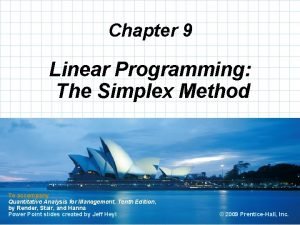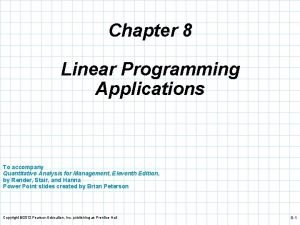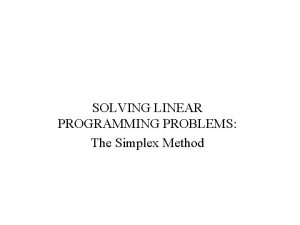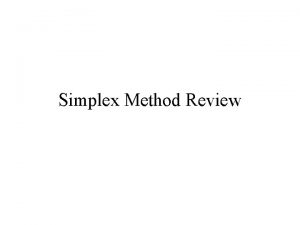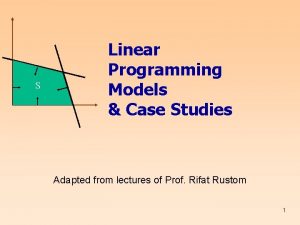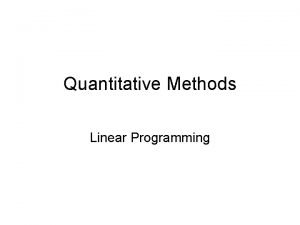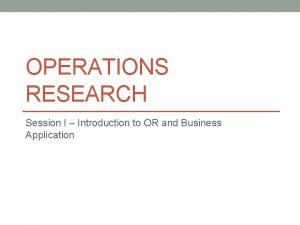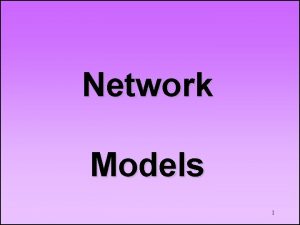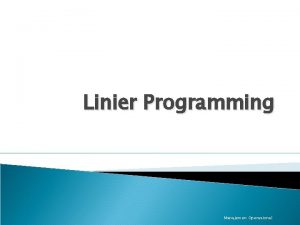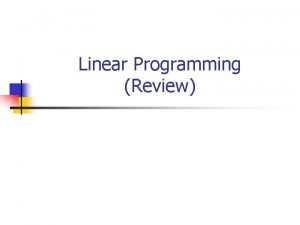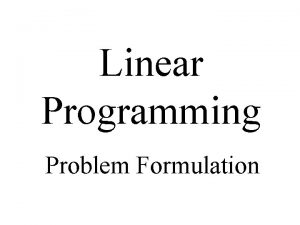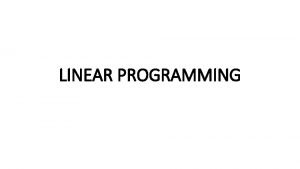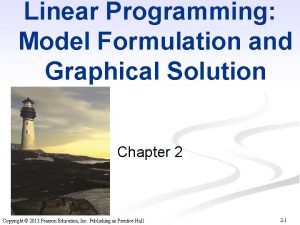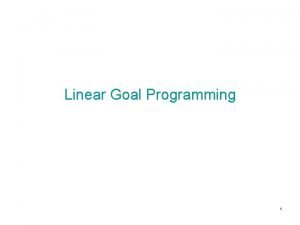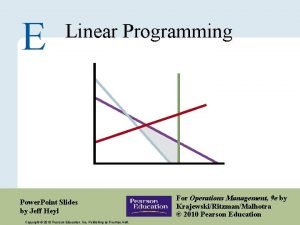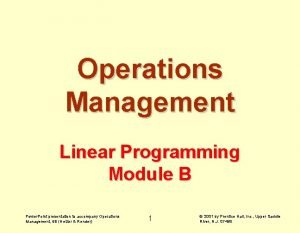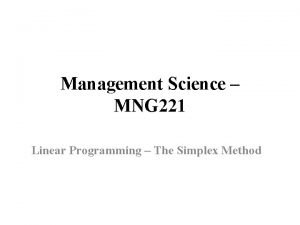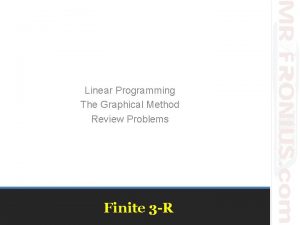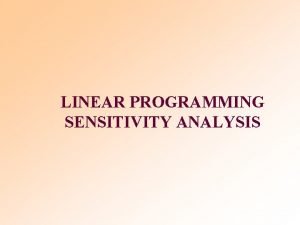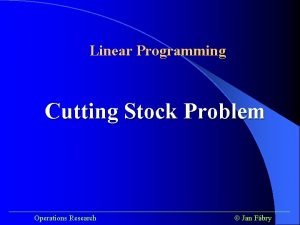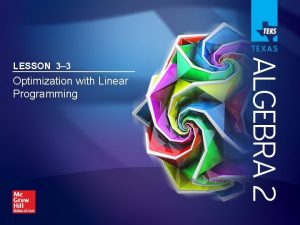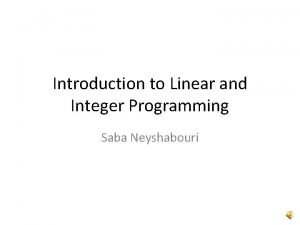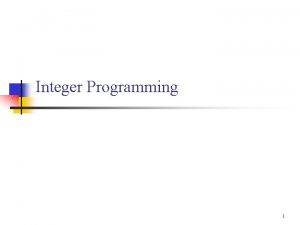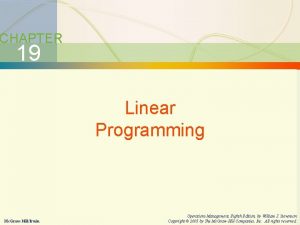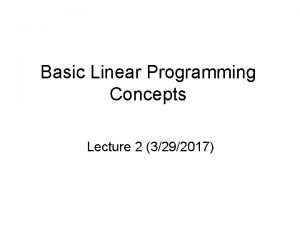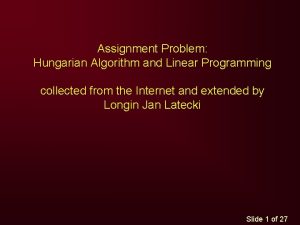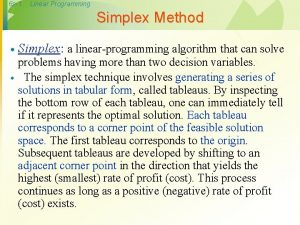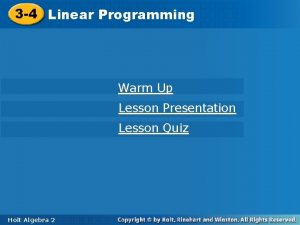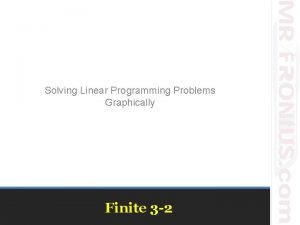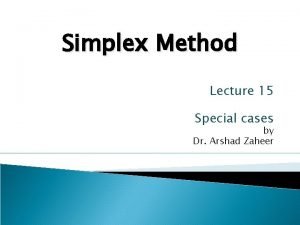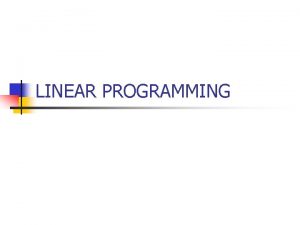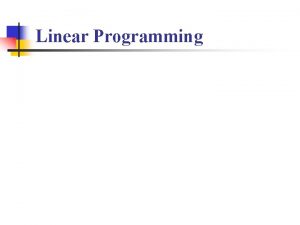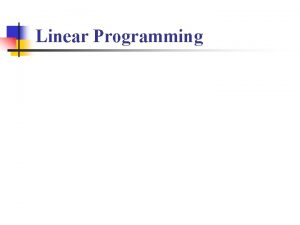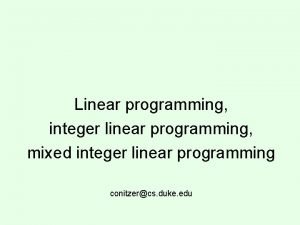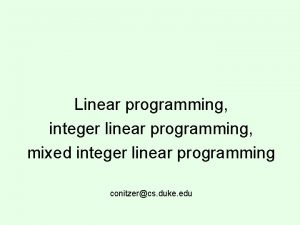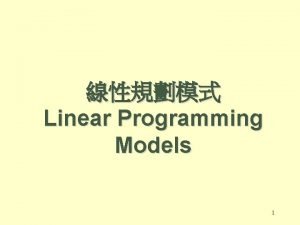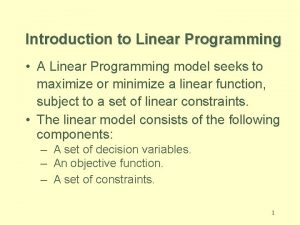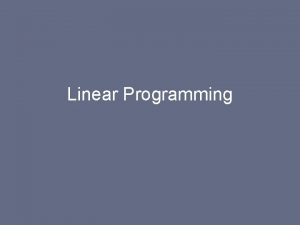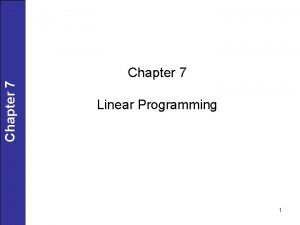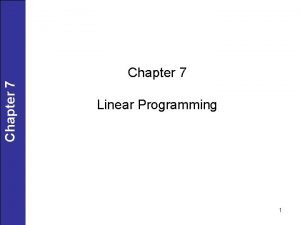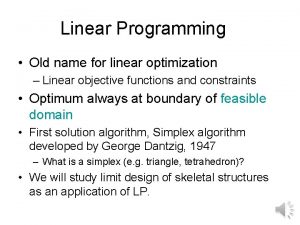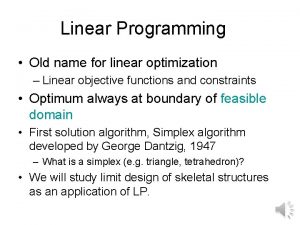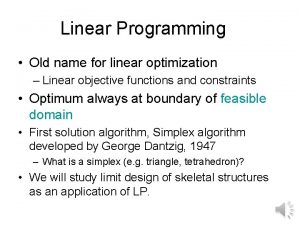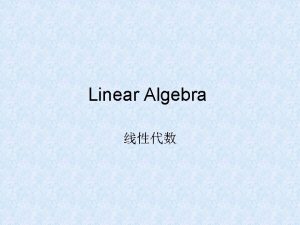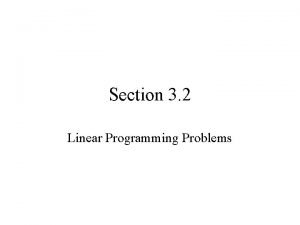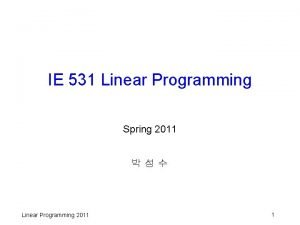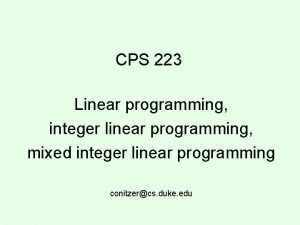Chapter 2 Introduction to Linear Programming Linear Programming












































- Slides: 44

Chapter 2: Introduction to Linear Programming Ø Ø Ø Ø Linear Programming Problem Formulation A Simple Maximization Problem Graphical Solution Procedure Extreme Points and the Optimal Solution Computer Solutions A Simple Minimization Problem Special Cases Slide 1

Linear Programming (LP) Problem • Linear programming (LP) involves choosing a course of action when the mathematical model of the problem contains only linear functions. (Note: Linear programming has nothing to do with computer programming. ) • The maximization or minimization of some quantity is the objective in all linear programming problems. • All LP problems have constraints that limit the degree to which the objective can be pursued. Slide 2

Linear Programming (LP) Terms • • • If both the objective function and the constraints are linear, the problem is referred to as a linear programming problem. Linear functions are functions in which each variable appears in a separate term raised to the first power and is multiplied by a constant (which could be 0). Linear constraints are linear functions that are restricted to be "less than or equal to", "equal to", or "greater than or equal to" a constant. A feasible solution satisfies all the problem's constraints. An optimal solution is a feasible solution that results in the largest possible objective function value when maximizing (or smallest when minimizing). A graphical solution method can be used to solve a linear program with two variables. Slide 3

Guidelines for Model Formulation • • • Problem formulation or modeling is the process of translating a verbal statement of a problem into a mathematical statement. Understand the problem thoroughly. Describe the objective. Describe each constraint. Define the decision variables. Write the objective in terms of the decision variables. Write the constraints in terms of the decision variables. Note: Formulating models is an art that can only be mastered with practice and experience. Every LP problems has some unique features, but most problems also have common features. Slide 4

LP Formulation: XYZ, Inc. q q q XYZ, Inc. manufactures two products, namely Product 1 and Product 2. The profits for Products 1 and 2 are $5 and $7 per unit, respectively. Due to demand limitations XYZ, Inc. should not produce more than 6 units of Product 1. Both products are made from steel and wood. Product 1 needs 2 pounds of steel and 1 cubic foot of wood, while Product 2 needs to 3 pounds of steel and 1 cubic foot of wood. Currently XYZ, inc. has 19 pounds of steel and 8 cubic feet of wood. Formulate the problem above and determine the optimal solution. Describe the objective. Describe each constraint. Define the decision variables. Slide 5

Example: XYZ, Inc. Mathematical Model • Define the decision variables x 1 = number of units of Product 1 to produce x 2 = number of units of Product 2 to produce • Objective: Maximize profit Maximize: 5 x 1 + 7 x 2 • Constraint 1: Demand limitation of product 1 x 1 < 6 Slide 6

Example: XYZ, Inc. (Continued) Mathematical Model • Constraint 2: Steel Limitation 2 x 1 + 3 x 2 < 19 • Constraint 3: Wood Limitation x 1 + x 2 < 8 • Cannot produce negative units of products 1 and 2 x 1 > 0 and x 2 > 0. Slide 7

XYZ, Inc. : A Simple Maximization Problem LP Formulation Max 5 x 1 + 7 x 2 s. t. x 1 2 x 1 + 3 x 2 x 1 + x 2 Objective Function < < < x 1 > 0 and x 2 > 0 6 19 8 “Regular” Constraints Non-negativity Constraints Slide 8

Example 1: Graphical Solution First Constraint Graphed x 2 8 7 6 x 1 = 6 (1: Product 1 Demand) Shaded region contains all feasible points for this constraint 5 4 3 2 (6, 0) 1 1 2 3 4 5 6 7 8 9 10 x 1 Slide 9

Example 1: Graphical Solution n Second Constraint Graphed x 2 8 (0, 6 1/3) 7 6 2 x 1 + 3 x 2 = 19 (2: Steel) 5 4 3 2 1 Shaded region contains all feasible points for this constraint 1 2 3 4 5 (9 1/2, 0) 6 7 8 9 10 x 1 Slide 10

Example 1: Graphical Solution n Third Constraint Graphed x 2 (0, 8) 8 7 x 1 + x 2 = 8 (3: Wood) 6 5 4 3 2 1 Shaded region contains all feasible points for this constraint 1 2 3 4 (8, 0) 5 6 7 8 9 10 x 1 Slide 11

Example 1: Graphical Solution n Feasible region: collection of points that satisfy ALL constraints x 2 x 1 + x 2 = 8 (3: Wood) 8 7 x 1 = 6 (1: Demand) 6 5 4 3 2 x 1 + 3 x 2 = 19 (2: Steel) Feasible Region 2 1 1 2 3 4 5 6 7 8 9 10 x 1 Slide 12

Example 1: Graphical Solution n Objective Function Line x 2 8 7 (0, 5) 6 Objective Function 5 x 1 + 7 x 2 = 35 5 4 3 2 (7, 0) 1 1 2 3 4 5 6 7 8 9 10 x 1 Slide 13

Example 1: Graphical Solution n Selected Objective Function Lines x 2 8 7 5 x 1 + 7 x 2 = 35 6 5 x 1 + 7 x 2 = 39 5 4 5 x 1 + 7 x 2 = 42 3 2 1 1 2 3 4 5 6 7 8 9 10 © 2011 Cengage Learning. All Rights Reserved. May not be scanned, copied or duplicated, or posted to a publicly accessible website, in whole or in part. x 1 Slide 14

Example 1: Graphical Solution n Optimal Solution x 22 8 x 1 + x 2 = 8 (3: Wood) Maximum Objective Function Line 5 x 1 + 7 x 2 = 46 Optimal Solution (x 1 = 5, x 2 = 3) 7 6 5 4 x 1 = 6 (1: Demand) 3 Feasible Region 2 1 1 2 3 4 2 x 1 + 3 x 2 = 19 (2: Steel) 5 6 7 8 9 10 xx 11 Slide 15

Binding and Non-Binding Constraints n n n A Constraint is binding if its resource is completely used up (i. e. , no slack). Steel and wood constraints are binding. Optimal Solution: (x 1 = 5, x 2 = 3) 2 x 1 + 3 x 2 < 19 (2: Steel) x 1 + x 2 < 8 (3: Wood) 2(5) + 3(3) = 19 5+3 = 8 A constraint is not binding is its resource is not completely used up. Product 1 demand is not binding. x 1 < 6 (1: Demand) x 1 = 5 (One unit left over called a ‘slack’) Slide 16

Summary of the Graphical Solution Procedure for Maximization Problems • • • Prepare a graph of the feasible solutions for each of the constraints. Determine the feasible region that satisfies all the constraints simultaneously. Draw an objective function line. Move parallel objective function lines toward larger objective function values without entirely leaving the feasible region. Any feasible solution on the objective function line with the largest value is an optimal solution. Slide 17

Slack and Surplus Variables • • A linear program in which all the variables are nonnegative and all the constraints are equalities is said to be in standard form. Standard form is attained by adding slack variables to "less than or equal to" constraints, and by subtracting surplus variables from "greater than or equal to" constraints. Slack and surplus variables represent the difference between the left and right sides of the constraints. Slack and surplus variables have objective function coefficients equal to 0. Slide 18

Slack Variables (for < constraints) • Example 1 in Standard Form Max s. t. 0 5 x 1 + 7 x 2 + 0 s 1 + 0 s 2 + 0 s 3 x 1 + s 1 = 6 2 x 1 + 3 x 2 + s 2 = 19 x 1 + x 2 + s 3 = 8 x 1, x 2 , s 1 , s 2 , s 3 > s 1 , s 2 , and s 3 are slack variables Slide 19

Slack Variables n Optimal Solution x 2 Third 8 Constraint: x 1 + x 2 = 8 7 s 3 = 0 First Constraint: x 1 = 6 s 1 = 1 6 5 Second Constraint: 2 x 1 + 3 x 2 = 19 4 3 2 1 Optimal Solution (x 1 = 5, x 2 = 3) 1 2 3 4 s 2 = 0 5 6 7 8 9 10 © 2011 Cengage Learning. All Rights Reserved. May not be scanned, copied or duplicated, or posted to a publicly accessible website, in whole or in part. x 1 Slide 20

Extreme Points and the Optimal Solution • • The corners or vertices of the feasible region are referred to as the extreme points. An optimal solution to an LP problem can be found at an extreme point of the feasible region. When looking for the optimal solution, you do not have to evaluate all feasible solution points. You have to consider only the extreme points of the feasible region. Slide 21

Example 1: Extreme Points x 2 8 7 5 (0, 6 1/3) 6 5 4 4 (5, 3) 3 Feasible Region 2 1 3 (6, 2) 2 (6, 0) 1 (0, 0) 1 2 3 4 5 6 7 8 9 10 x 1 Slide 22

Interpretation of Computer Output LP problems involving 1000 s of variables and 1000 s of constraints are now routinely solved with computer packages. Linear programming solvers are now part of many spreadsheet packages, such as Microsoft Excel. • In this chapter we will discuss the following output: • objective function value • values of the decision variables • slack and surplus • In the next chapter we will discuss how an optimal solution is affected by a change in: • a coefficient of the objective function • the right-hand side value of a constraint • reduced costs • Slide 23

Computer Solutions: XYZ. Inc. n n For MAN 321, we will use QM for Windows Spreadsheet Showing Problem Data Slide 24

Computer Solutions: XYZ. Inc. n Spreadsheet Showing Solution Slide 25

Computer Solutions: XYZ. Inc. Spreadsheet Showing Ranging Note: Slacks/Surplus and Reduced Costs Slide 26

Example 1: Spreadsheet Solution Interpretation of Computer Output We see from the Slides 24 and 25 that: Objective Function Value Decision Variable #1 (x 1) Decision Variable #2 (x 2) Slack in Constraint #1 Slack in Constraint #2 Slack in Constraint #3 = 46 = 5 = 3 = 6– 5=1 = 19 – 19 = 0 = 8– 8=0 Slide 27

Example 2: A Simple Minimization Problem LP Formulation Min 5 x 1 + 2 x 2 s. t. 2 x 1 + 5 x 2 4 x 1 - x 2 x 1 + x 2 > > > 10 12 4 (1) (2) (3) x 1, x 2 > 0 Slide 28

Example 2: Graphical Solution Graph the Constraints Constraint 1: When x 1 = 0, then x 2 = 2; when x 2 = 0, then x 1 = 5. Connect (5, 0) and (0, 2). The ">" side is above this line. Constraint 2: When x 2 = 0, then x 1 = 3. But setting x 1 to 0 will yield x 2 = -12, which is not on the graph. Thus, to get a second point on this line, set x 1 to any number larger than 3 and solve for x 2: when x 1 = 5, then x 2 = 8. Connect (3, 0) and (5, 8). The ">“ side is to the right. Constraint 3: When x 1 = 0, then x 2 = 4; when x 2 = 0, then x 1 = 4. Connect (4, 0) and (0, 4). The ">" side Slide 29 is above this line.

Example 2: Graphical Solution Constraints x 2 Graphed 6 Feasible Region 5 4 x 1 - x 2 > 12 (2) 4 x 1 + x 2 > 4 (3) 3 2 x 1 + 5 x 2 > 10 (1) 2 1 1 2 3 4 5 6 x 1 Slide 30

Example 2: Graphical Solution Graph the Objective Function Set the objective function equal to an arbitrary constant (say 20) and graph it. For 5 x 1 + 2 x 2 = 20, when x 1 = 0, then x 2 = 10; when x 2= 0, then x 1 = 4. Connect (4, 0) and (0, 10). Move the Objective Function Line Toward Optimality Move it in the direction which lowers its value (down), since we are minimizing, until it touches the last point of the feasible region, determined by the last two constraints. Slide 31

Example 2: Graphical Solution Objective Function Graphed x 2 Min 5 x 1 + 2 x 2 6 5 4 x 1 - x 2 > 12 (2) 4 x 1 + x 2 > 4 (3) 3 2 x 1 + 5 x 2 > 10 (1) 2 1 1 2 3 4 5 6 x 1 © 2011 Cengage Learning. All Rights Reserved. May not be scanned, copied or duplicated, or posted to a publicly accessible website, in whole or in part. Slide 32

Example 2: Graphical Solution Solve for the Extreme Point at the Intersection of the Two Binding Constraints 4 x 1 - x 2 = 12 x 1+ x 2 = 4 Adding these two equations gives: 5 x 1 = 16 or x 1 = 16/5 Substituting this into x 1 + x 2 = 4 gives: x 2 = 4/5 Solve for the Optimal Value of the Objective Function 5 x 1 + 2 x 2 = 5(16/5) + 2(4/5) = 88/5 Slide 33

Example 2: Graphical Solution Optimal Solution x 2 6 4 x 1 - x 2 > 12 (2) 5 x 1 + x 2 > 4 (3) 4 2 Optimal Solution: x 1 = 16/5, x 2 = 4/5, 5 x 1 + 2 x 2 = 17. 6 1 2 x 1 + 5 x 2 > 10 (1) 3 1 2 3 4 5 6 x 1 © 2011 Cengage Learning. All Rights Reserved. May not be scanned, copied or duplicated, or posted to a publicly accessible website, in whole or in part. Slide 34

Summary of the Graphical Solution Procedure for Minimization Problems • • • Prepare a graph of the feasible solutions for each of the constraints. Determine the feasible region that satisfies all the constraints simultaneously. Draw an objective function line. Move parallel objective function lines toward smaller objective function values without entirely leaving the feasible region. Any feasible solution on the objective function line with the smallest value is an optimal solution. © 2011 Cengage Learning. All Rights Reserved. May not be scanned, copied or duplicated, or posted to a publicly accessible website, in whole or in part. Slide 35

Surplus Variables Example 2 in Standard Form Min 5 x 1 + 2 x 2 + 0 s 1 + 0 s 2 + 0 s 3 s. t. 2 x 1 + 5 x 2 - s 1 4 x 1 - x 2 - s 2 x 1 + x 2 - s 3 = 10 = 12 = 4 x 1, x 2, s 1, s 2, s 3 > 0 s 1 , s 2 , and s 3 are surplus variables © 2011 Cengage Learning. All Rights Reserved. May not be scanned, copied or duplicated, or posted to a publicly accessible website, in whole or in part. Slide 36

Example 2: Spreadsheet Solution Interpretation of Computer Output Objective Function Value Decision Variable #1 (x 1) Decision Variable #2 (x 2) Surplus in Constraint #1 Surplus in Constraint #2 Surplus in Constraint #3 = 17. 6 = 3. 2 = 0. 8 = 10. 4 - 10 = 0. 4 = 12. 0 - 12 = 0. 0 = 4. 0 - 4 = 0. 0 © 2011 Cengage Learning. All Rights Reserved. May not be scanned, copied or duplicated, or posted to a publicly accessible website, in whole or in part. Slide 37

Types of Possible LP Solutions • Unique Optimal Solution • Alternative Optimal Solutions In the graphical method, if the objective function line is parallel to a boundary constraint in the direction of optimization, there alternate optimal solutions, with all points on this line segment being optimal. • Infeasible Solution No solution to the LP problem satisfies all the constraints. Graphically, this means a feasible region does not exist. • Unbounded Solution. The objective function that can be increased without bound (i. e. , unbounded solution) for maximization problem. Slide 38

A) Alternative Optimal Solutions Consider the following LP problem. Max 4 x 1 + 6 x 2 s. t. x 1 2 x 1 + 3 x 2 x 1 + x 2 < 6 (1) < 18 (2) < 7 (3) x 1 > 0 and x 2 > 0 © 2011 Cengage Learning. All Rights Reserved. May not be scanned, copied or duplicated, or posted to a publicly accessible website, in whole or in part. Slide 39

Alternative Optimal Solutions (Cont. ) Boundary constraint 2 x 1 + 3 x 2 < 18 and objective function Max 4 x 1 + 6 x 2 are parallel. All points on line segment A – B are optimal solutions. x 2 x + x < 7 (3) 1 7 6 5 2 Max 4 x 1 + 6 x 2 A B 4 x 1 < 6 (1) 2 x 1 + 3 x 2 < 18 (2) 3 2 1 1 2 3 4 5 6 7 8 9 10 © 2011 Cengage Learning. All Rights Reserved. May not be scanned, copied or duplicated, or posted to a publicly accessible website, in whole or in part. x 1 Slide 40

B) Infeasible Problem • Causes include: • A formulation error has been made. • Management’s expectations are too high. • Too many restrictions have been placed on the problem (i. e. the problem is over-constrained). Consider the following LP problem. Max 2 x 1 + 6 x 2 s. t. 4 x 1 + 3 x 2 < 12 (1) 2 x 1 + x 2 > 8 (2) x 1, x 2 > 0 Slide 41

Infeasible Problem (Cont. ) There are no points that satisfy both constraints, so there is no feasible region (and no feasible solution). x 2 10 2 x 1 + x 2 > 8 (2) 8 6 4 x 1 + 3 x 2 < 12 (1) 4 2 2 4 6 8 10 x 1 Slide 42

C) Unbounded Solution For real problems, this is the result of improper formulation. (Quite likely, a constraint has been inadvertently omitted. ) Consider the following LP problem. Max 4 x 1 + 5 x 2 s. t. x 1 + x 2 > 5 (1) 3 x 1 + x 2 > 8 (2) x 1, x 2 > 0 Slide 43

Unbounded Solution (Cont. ) The feasible region is unbounded and the objective function line can be moved outward from the origin without bound, infinitely increasing the objective x 2 function. 10 3 x 1 + x 2 > 8 (2) 8 M ax 6 4 4 x 1 +5 x 2 x 1 + x 2 > 5 (1) 2 2 4 6 8 10 x 1 Slide 44
 Perbedaan linear programming dan integer programming
Perbedaan linear programming dan integer programming Integer programming vs linear programming
Integer programming vs linear programming Definisi integer
Definisi integer Cj-zj meaning
Cj-zj meaning Qm for windows
Qm for windows Chapter 8 linear programming applications solutions
Chapter 8 linear programming applications solutions Computer programming chapter 1
Computer programming chapter 1 History of python
History of python Chapter 1 introduction to computers and programming
Chapter 1 introduction to computers and programming C programming chapter 1
C programming chapter 1 Greedy vs dynamic
Greedy vs dynamic What is system program
What is system program Simplex method problem
Simplex method problem Difference constraints and shortest paths
Difference constraints and shortest paths Canonical form linear programming
Canonical form linear programming Linear programming case study examples
Linear programming case study examples Linear programming in quantitative techniques
Linear programming in quantitative techniques Scope of linear programming
Scope of linear programming Network model linear programming
Network model linear programming Linear programming management science
Linear programming management science Pengertian linear programming
Pengertian linear programming Linear programming word problems
Linear programming word problems Characteristic of linear programming
Characteristic of linear programming An animal feed company must produce
An animal feed company must produce Pengertian linear programming
Pengertian linear programming Linear programming formulation
Linear programming formulation Linear vs integer programming
Linear vs integer programming Scope of linear programming
Scope of linear programming Preemptive goal programming examples
Preemptive goal programming examples Linear programming powerpoint
Linear programming powerpoint Operations management linear programming
Operations management linear programming Cj - zj
Cj - zj Linear programming graphical calculator
Linear programming graphical calculator Sensitivity range linear programming
Sensitivity range linear programming Linear programming operations research
Linear programming operations research 3-3 optimization with linear programming
3-3 optimization with linear programming Saba neyshabouri
Saba neyshabouri Lp relaxation 이란
Lp relaxation 이란 Operations management linear programming
Operations management linear programming Linear programming basic concepts
Linear programming basic concepts Linear programming assignment problem example
Linear programming assignment problem example Big m method in lpp
Big m method in lpp 3-4 linear programming
3-4 linear programming 6x4x2x3
6x4x2x3 Simplex method example
Simplex method example



